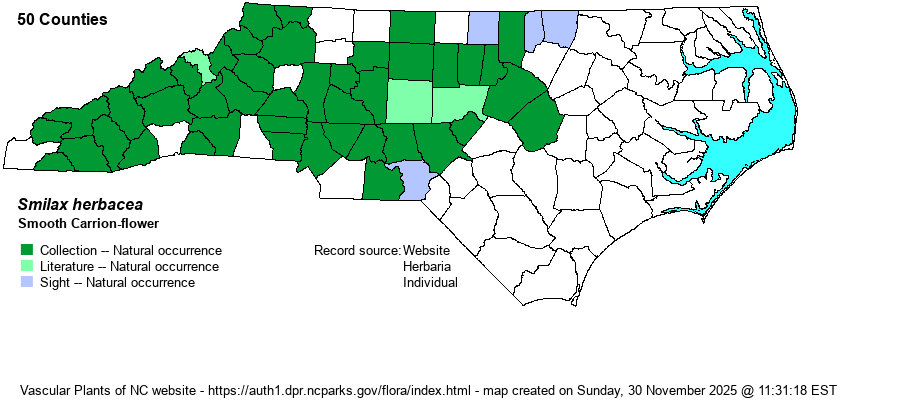| Author | L. | |
| Distribution | Throughout the Mountains and Piedmont. Apparently not present in the Coastal Plain or Sandhills proper. Note: The very similar S. pulverulenta and S. lasioneura were split out from S. herbacea (sensu lato) and have a roughly similar range in the state. Thus, details of the distribution (and abundance) of each is unsettled until specimens can be examined.
This is a Northern species occurring from southern Canada south to central GA and central AL, essentially not present in the Coastal Plain south of VA (except in AL).
| |
| Abundance | Apparently fairly common to common in the Mountains; fairly common in the Piedmont, more numerous in the western portion than near the Fall Line, where it is uncommon. Exact details of abundance are not clear, as S. pulverulenta also occurs in much of the state; and S. lasioneura is present in small numbers also. | |
| Habitat | This species favors moist to rich woods, often in fairly high pH soils. It can occur both in bottomland forests and on moist slopes. |
| Phenology | Blooms in May and June, and fruits from August to October. | |
| Identification | This is one of the several herbaceous “vines” in the genus Smilax, which also includes woody vines and erect herbs. This species grows to 2-3’ feet long and climbs over low shrubs, or trails close to the ground. It and other herbaceous species lack spines or thorns. The leaves are alternate on the stem and are ovate, entire, and grow to about 3 inches long. The leaf base is cordate, and the outline of the leaf is convex to an acute tip. The underside of the leaf is glabrous and somewhat pale green. Dense “balls” of flowers and berries appear along the stem. In addition to several other herbaceous species of Smilax, which see in their accounts, the species can be confused with two recent splits -- S. pulverulenta and S. lasioneura; see the accounts of those species for identification information. The more common Wild Yam (Dioscorea villosa) and other exotic yam species can also be confused with Smilax species; however, that genus has generally whorled leaves, with several coming off the stem at the same place. Both genera are twining vines, so make sure the vine has distinctly alternate leaves with no whorls of leaves to eliminate Dioscorea species. The inflorescences of the two genera are completely different, but normally one sees vegetative plants for much of the year. | |
| Taxonomic Comments | Older references, such as RAB (1968), had this taxon as one of several in the all-inclusive S. herbacea (sensu latu). This taxon, of course, was named as S. herbacea var. herbacea. Now, S. pulverulenta has been split out as a separate species.
| |
| Other Common Name(s) | Common Carrion-flower, Carrion-flower, Smooth Herbaceous Greenbrier | |
| State Rank | S5 [S4?] | |
| Global Rank | G5 | |
| State Status | | |
| US Status | | |
| USACE-agcp | FAC link |
| USACE-emp | FAC link |

